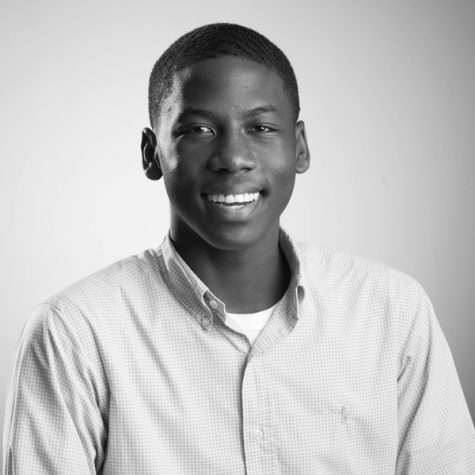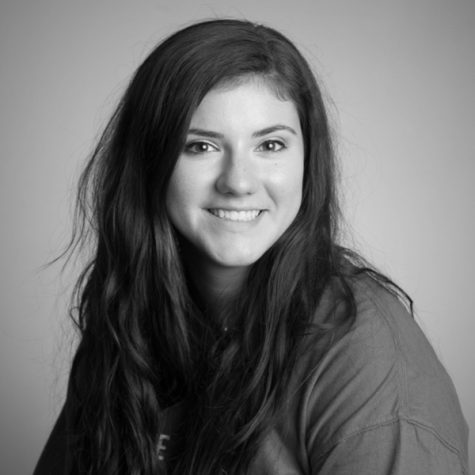It’s not all black and white
Thoughts on being a minority in a majority
Photo by Kayleigh Moreland
Junior Ricky reads in his AP English class.
February 16, 2016
Go to school. Work hard. Make good grades. Be competitive.
Those four things have been my main goals since the third grade, when I didn’t feel like the absolute smartest kid anymore. I started school at Martha and Josh Morriss Elementary School in the third grade, and it’s a school full of the district’s brightest kids. It was when I went to Morriss that I realized:
- I had to work hard to succeed (for a 9-year-old).
- Other people were going to work harder.
- I was one of five minorities out of my class of 60 kids.
Being less than 10 years old, I never truly understood what it meant to be someone who wasn’t in the majority. In elementary school, I was never approached with any stigmas or negativity about the color of my skin. However, deep down, I felt as if I had to prove that I was better, if not equal, to the white kids all around me.
I’m comfortable with the way that I live, and I am so thankful that I was able to grow up with parents who got me everything I needed, and almost everything I wanted. Surrounded by kids who acted like me for three years, I didn’t realize a major difference between any students until I went to middle school.
In the sixth grade, I realized that there are significantly different types of people who attend school. Texas Middle School was a melting pot of different personalities, backgrounds and races. TMS also had a much larger number of minorities, especially black kids like myself. I finally felt as though I could prosper as someone who didn’t have to prove himself.
What I definitely didn’t expect in middle school was to feel apart from nearly every other black person at the school. Growing up with primarily white children, I dressed differently, spoke differently and took different classes than the majority of other black kids.
Because of this, I saw the pointed looks, loud laughs and eye rolls from other black kids across the hallway. I felt insecure and almost like a traitor to my own race, but being so young, it’s hard to branch out and meet new people who aren’t in the same classes.
Now that I’m in high school, I am a lot more comfortable with who I am. However, in my advanced courses, I am one of the few (if not the only) black people. Regardless, I’m a successful student because of the person that I am, not who my friends are or the color of their skin.
Sure, it kind of hurts that I hear about black kids who don’t want to take AP courses because they’re “white people classes.” It’s alarming to me that two years ago, only 7.5 percent of black students at Texas High School were in AP classes, while 32.5 percent of white students took AP courses. These numbers make me feel worried about the future of black students. Black students will be less competitive for jobs in the future against white students that took AP courses in high school.
As senior year approaches, it’s almost no easier to identify with the majority of black students, but I’m content with the black person that I am. The past year has been phenomenal: I was elected class president, started my term as vice president of the Texas Association of Student Councils and have somehow managed to keep my grades up in the midst of it all. I’m an involved student, and race isn’t a factor anymore– not to me at least.
I’ve realized that my insecurities and self-doubt came along with comparison and envy for white and black students everywhere. Now, I try my hardest to be a role model; not only for African-Americans all over, but for everyone that I encounter. I’ve accomplished so many things as myself— not as the “white kid in a black body,” or the “black kid with white friends.” I’m happy with who I am, where I come from, the color of my skin and the people I’m friends with.
Life goes on after high school, and you can bet I’ll keep going too.

















Lisa Milker • Aug 2, 2016 at 10:17 am
Awesome!! Keep striving to be the best you that you can be!
Nicole Ayers • Feb 21, 2016 at 12:33 pm
Excellent article, Ricky. Thank you for your transparency in sharing your mind and heart. You are a role model and inspiration to many; keep up the excellent work!
Tonya Dumdei • Feb 19, 2016 at 8:03 pm
Hi, Ricky. I work for TISD and really enjoyed your article. Your writing showed us the real struggle that can take place as we work with our students. Thanks for sharing so honestly. Continue to stay true to who you are and you have a bright future ahead!
Ricky Cooks • Feb 21, 2016 at 9:52 pm
Thank you so much!!! I appreciate this so much!
Naveen • Feb 17, 2016 at 6:11 pm
WOOO RICKY BABY THIS IS GREAT I AM SO PROUD OF U
Ricky Cooks • Feb 21, 2016 at 9:53 pm
LOVE U
Pat Skelton • Feb 17, 2016 at 5:20 pm
Ricky, as a retired teacher from TISD and TASD, I’m so proud of who you are! I wish all students could read this, follow your 4 rules, and become proud of themselves instead of becoming rebellious. I’m looking forward to following you throughout your future. Our country needs people like you to guide our future. I have no doubt that wherever life leads you, you will be successful.
Ricky Cooks • Feb 21, 2016 at 9:57 pm
Thank you! I’m really glad that my words can MAYBE spark some influence! I appreciate the kind words.